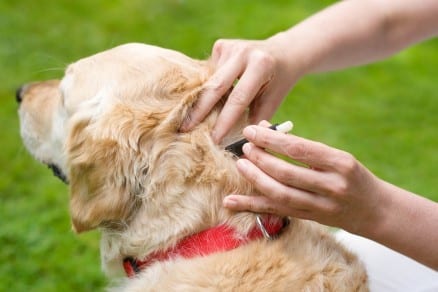
The tick population in the U.S. has exploded in recent years, causing a drastic increase in cases of Lyme disease, Rocky Mountain spotted fever, and other tick-borne illnesses among people and pets.
Sometimes, it seems, that despite our best efforts to keep our pets close, we still wind up pulling ticks off them every spring, summer, and fall. Understanding how ticks get on pets (and people) and what you can do about it is crucial to winning the fight against tick-borne disease.
Mystery Solved: How Ticks Get on Pets
Ticks aren’t able to see a potential host, but they are attracted by warmth and movement in their environment via special sensory organs on their legs. In a highly effective strategy called “questing,” ticks will climb onto a tall plant or blade of grass and hold their legs out in front of them. Special sensory structures on the legs, known as Haller’s organs, alert the tick to an approaching animal by detecting exhaled carbon dioxide and the aroma of sweat.
As soon as an unsuspecting mammal walks by, it can be ambushed. Ticks don’t jump, but they can move quickly. Although contact with ticks is more common outside, ticks can find their way inside our homes, hitching a ride on the fur of our pets. As a result, ticks still pose a threat to family members and other indoor-only pets in the household.
Prevent and Protect
Ticks get on pets quite easily – after all, it’s what they’ve evolved to do. It’s nearly impossible to go through life without ever being near a tick, but there are steps pet owners can take to reduce the risk of coming into contact with one:
- Keep your pet on a year-round flea and tick preventive. Yes, even your indoor-only pet!
- Check your pet daily for ticks, especially after coming in from outdoors. Promptly remove any that you find.
- Keep your dog leashed at all times, and don’t let them stray from paths and trails.
- Don’t allow your pet to come into contact with any wildlife (dead or alive), as ticks can migrate from one animal to another.
- Keep tall grasses and shrubbery trimmed in your yard, and make sure there are no piles of leaves or debris that may harbor ticks.
With a little planning and a lot of awareness, you can decrease your pet’s chances of encountering a tick. Please contact the staff at Schertz Animal Hospital for more information or to schedule an appointment for your pet.
Recent Posts
About Us
We know that choosing the right veterinarian for your pet (and you) can be a challenge. Yet, with our stress-free handling, our long-term, experienced staff, and a state-of-the-art facility, we make the decision an easy one!
